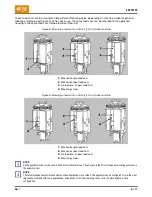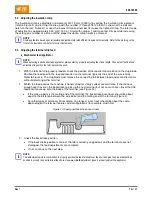
408-10390
Rev
T
20
of 25
6. Check the worn shear plates to determine whether they can be reoriented to provide another usable
shearing edge.
Most rear plates are the same at the front and rear. If so, and if the second side is not worn, turn
the plate front to the rear, making sure that the widest part of the chip clearance groove is at the
bottom.
If the front plate is completely symmetrical, turn it so that any unused edge is at the top rear.
If the front plate does not require spacers and is the same on the top and bottom, turn it top to
bottom (if the bottom edge is not already worn).
Make sure that the grooves face the rear shear plate.
7. With the old plates reoriented or the new plates properly positioned, install the shear plates and
spacers (if used).
8. Fasten them in place with the two screws.
9. Hold the top of the ram assembly with one hand, while moving the feed pawl with the other hand.
Slowly lower the ram assembly to check the alignment of the slug blade with the shear plates.
If side-to-side alignment is needed, loosen the two screws holding the shear plates, and move the
plates to line them up properly. Re-tighten the screws.
If front-to-back alignment is needed, lay the applicator carefully on its side, and slightly loosen the
four screws that hold the strip guide plate to the base plate. Move the strip guide plate in the
required direction until the slug blade can pass freely between the shear plates. With the slug
blade between the shear plates, retighten the four screws.
10. Set the applicator upright. Raise the ram assembly until the slug blade is clear of the shear plates.
11. Lower and raise the ram assembly several times to make sure that the slug blade moves in and out of
the shear plates freely.
12. Lift the stock drag and feed pawl.
13. Slide the terminal strip section forward until the lead terminal is over the anvil.
6.4.
Replacing the crimper
1. Loosen the crimper bolt slightly
2. Remove the ram assembly from applicator by pulling upward. It might be necessary to move the feed
pawl forward to release the ram assembly.
3. Record the location of parts for reinstallation.
4. Remove the crimper bolt that holds the front shear depressor, front shear depressor spacer, tubular
spacer, insulation crimper, crimper spacer, and wire crimper in place on the ram assembly.
5. Reinstall the parts by reversing the order of step 4. The upper end of the wire crimper must be up
against the shoulder of the ram assembly.
6. Tighten the crimper bolt
only
finger-tight.
NOTE
Crimpers
must
be positioned with the part number facing up. If new parts are used, make sure that the part numbers agree
with the numbers on the applicator parts list.
7. Put the ram assembly back into the applicator.
8. Install the applicator in machine.
9. Lift the feed pawl and pull the terminal strip back until the lead terminal is between the strip guides.
10. Form a piece of heavy paper over the anvil.






































